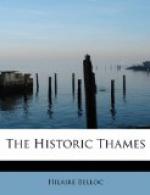In most rivers one has nothing more to do in describing those two sections than to show how gradually they merge into one another. In most rivers the passage of the upper waters is perfectly easy, and as one descends the fords get rarer and rarer, until at last they cease.
With the Thames this is not the case. The two portions of the river are sharply divided in the vicinity of Oxford, and that for reasons which we have already seen when we were speaking of the suitability of its banks for habitation. The upper Thames is indeed shallow and narrow, and there are innumerable places above Oxford where it could be crossed, so far as the volume of its waters was concerned. It was crossed by husbandmen wherever a village or a farm stood upon its banks. Perhaps the highest point at which it had to be crossed at one chosen spot is to be discovered in the word Somer_ford_ Keynes, but the ease with which the water itself could be traversed is apparent rather in the absence than in the presence of names of this sort upon the upper Thames. Shifford, for instance, which used to be spelt Siford, may just as well have been named from the crossing of the Great Brook as from the crossing of the Thames. The only other is Duxford.
While, however, the upper Thames was thus easy to cross where individuals only or small groups of cattle were concerned, the marshes on either side always made it difficult for an army. The records of early fighting are meagre, and often legendary, but such as they are you do not find the upper Thames crossed and recrossed as are the upper Severn or the upper Trent. There are two points of passage: Cricklade and Oxford, nor can the passage from Oxford be made westward over the marshes. It is confined to the ford going north and south.
Below Oxford, after the entry of the Cherwell, and from thence down to a point not very easily determined, but which is perhaps best fixed at Wallingford, the Thames is only passable at fixed crossings in ordinary weather, as at Sandford, where the hard gravels approach the bank upon either side, and at other places, each distant from the next by long stretches of river.
It is not easy, now that the river has been locked, to determine precisely where all these original crossings are to be found.
The records of Abingdon and its bridge make it certain that a difficult ford existed here; the name “Burford” attached to the bridge points to the ancient ford at this spot. It is a name to be discovered in several other parts of England where there has been some ancient crossing of a river, as, for instance, the crossing of the Mole in Surrey by the Roman military road.
The next place below Abingdon may have been at Appleford, but was more likely between the high cliff at Clifton-Hampden and the high and dry spit of Long Wittenham. Below this again for miles there was no easy crossing of the river.
The Thames was certainly impassable at Dorchester. The whole importance of Dorchester indeed in history lies in its being a strong fortified position, and it depends for its defence upon the depth of the river, which swirls round the peninsula occupied by the camp.




